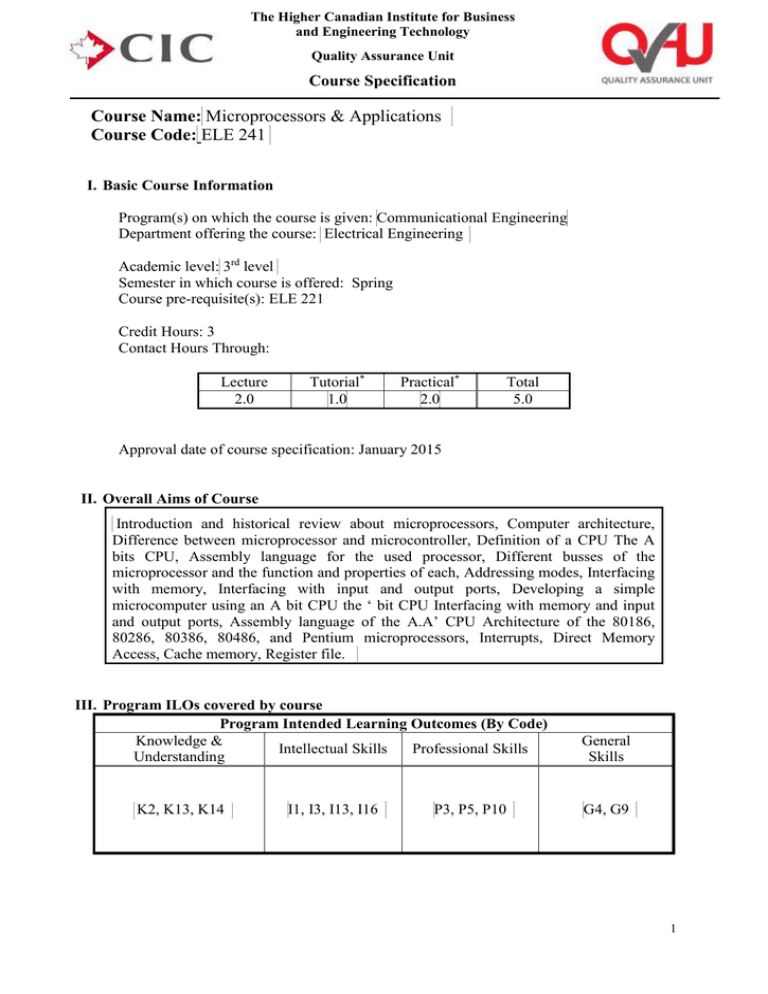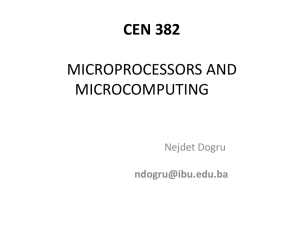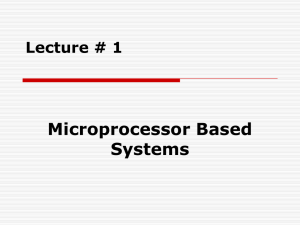course title (course code) - Canadian International College
advertisement

The Higher Canadian Institute for Business and Engineering Technology Quality Assurance Unit Course Specification Course Name: Microprocessors & Applications Course Code: ELE 241 I. Basic Course Information Program(s) on which the course is given: Communicational Engineering Department offering the course: Electrical Engineering Academic level: 3rd level Semester in which course is offered: Spring Course pre-requisite(s): ELE 221 Credit Hours: 3 Contact Hours Through: Lecture 2.0 Tutorial* 1.0 Practical* 2.0 Total 5.0 Approval date of course specification: January 2015 II. Overall Aims of Course Introduction and historical review about microprocessors, Computer architecture, Difference between microprocessor and microcontroller, Definition of a CPU The A bits CPU, Assembly language for the used processor, Different busses of the microprocessor and the function and properties of each, Addressing modes, Interfacing with memory, Interfacing with input and output ports, Developing a simple microcomputer using an A bit CPU the ‘ bit CPU Interfacing with memory and input and output ports, Assembly language of the A.A’ CPU Architecture of the 80186, 80286, 80386, 80486, and Pentium microprocessors, Interrupts, Direct Memory Access, Cache memory, Register file. III. Program ILOs covered by course Program Intended Learning Outcomes (By Code) Knowledge & Intellectual Skills Professional Skills Understanding K2, K13, K14 I1, I3, I13, I16 P3, P5, P10 General Skills G4, G9 1 The Higher Canadian Institute for Business and Engineering Technology Quality Assurance Unit Course Specification IV. Intended Learning Outcomes of Course (ILOs) a. Knowledge and Understanding On completing the course, students should be able to: k1. Recognize principles of design including elements design, process and/or a system related to specific disciplines. k2. List methodologies of solving engineering problems, data collection and interpretation k3. Define current engineering technologies as related to disciplines. k4. Recognize the structure of microprocessor. k5. Recognize the relation between programming and machine code k6. Classify microprocessors based on their capabilities. k7. Explain timing diagrams of digital systems b. Intellectual/Cognitive Skills On completing the course, students should be able to: i.1 Think in a creative problem design i.2 Assess and evaluate the characteristics and performance of components, systems and processes. i.3 Solve engineering problems, often on the basis of limited and possibly contradicting information. i.4 Optimize the programming of microprocessor based on generated machine code i.5 Design memory interface circuit based on the type of the microprocessor. c. Practical/Professional Skills On completing the course, students should be able to: i.1 Use appropriate tools to measure system performance. i.2 Measure digital signals and verify its logic state i.3 Execute different assembly programs and observe the status of the microprocessor. i.4 Sketch timing diagram of digital circuits. i.5 Compute the size of each instruction in memory. d. General and Transferable Skills On completing the course, students should be able to: g.1 Demonstrate efficient IT capabilities. V. Course Matrix Contents Main Topics / Chapters 12345- Introduction, and historical discussion of microprocessor Internal structure of 8088/8086 microprocessor General purpose registers Segment registers and pointer and index registers Flag register Duration (Weeks) Course ILOs Covered by Topic (By ILO Code) K&U I.S. P.S. G.S. 1 k1 1 k1,k6 1 k4,k3 1 k4 1 k4 2 The Higher Canadian Institute for Business and Engineering Technology Quality Assurance Unit Course Specification 6789- Addressing modes Midterm Exam Machine code Address-data de-multiplexing Timing diagram (read and 10write cycle) 11- Memory interface to 8088 1 k2 i3 1 1 k5 k7 i4 p5 1 k7 i5 p4 1 k1 i5 12- Memory interface to 8086 1 k1 i5 1 k1,k3 i5 1 k2 i3 Memory interface to 80486 and Pentium 14- Interrupt 15- Final Exam Net Teaching Weeks 13- 13 VI. Course Weekly Detailed Topics / hours / ILOs Week No. 1 2 3 4 5 6 7 8 9 10 11 12 13 14 15 Sub-Topics Introduction, and historical discussion of microprocessor Internal structure of 8088/8086 microprocessor General purpose registers Segment registers and pointer and index registers Flag register Addressing modes Midterm Exam Machine code Address-data de-multiplexing Timing diagram (read and write cycle) Memory interface to 8088 Memory interface to 8086 Memory interface to 80486 and Pentium Interrupt Final Exam Total Teaching Hours Total Hours Contact Hours Theoretical Practical Hours Hours* 2 2 5 2 3 5 2 3 5 2 3 5 5 2 2 3 3 5 5 5 5 5 5 5 2 2 2 2 2 2 2 3 3 3 3 3 3 3 3 The Higher Canadian Institute for Business and Engineering Technology Quality Assurance Unit Course Specification Teaching/Learning Method Selected Method VII. Teaching and Learning Methods √ √ √ √ Lectures & Seminars Tutorials Computer lab Sessions Practical lab Work Reading Materials Web-site Searches Research & Reporting Problem Solving / Problem-based Learning Projects Independent Work Group Work Case Studies Presentations Simulation Analysis Course ILOs Covered by Method (By ILO Code) K&U All All Intellectual Skills i3,i4,i5 i1,i2 √ i1,i3 √ i3,i4,i5 √ i2 Professional Skills p4,p5 p4,p5 p1,p2 p1,p2 General Skills g1 Others (Specify): Selected Method VIII. Assessment Methods, Schedule and Grade Distribution Course ILOs Covered by Method (By ILO Code) Assessment Method K&U I.S. P.S. G.S. Midterm Exam Final Exam Quizzes Course Work Report Writing Case Study Analysis Oral Presentations Practical Group Project Individual Project √ √ √ √ √ √ √ √ √ √ √ √ √ √ Assessment Weight / Percentage Week No. 20% [50%] 5% 10% 5% 7 15 3-6-9-11 3-11 5-10 5% 5% Others (Specify): 4 The Higher Canadian Institute for Business and Engineering Technology Quality Assurance Unit Course Specification IX. List of References Essential Text Books Course notes Recommended books Periodicals, Web sites, etc … INTEL Microprocessors 8086/8088, 80186/80188, 80286, 80386, 80486, Pentium, Prentium ProProcessor, Pentium II, III, 4 (7th Edition5, Barry B. Brey, Prentice Hall Lecture Notes X. Facilities required for teaching and learning PC-Computer Data show White Board Marker Course coordinator: Dr. Sameh Abdel Rahman Head of Department: Ass. Prof. Dr. Tamer Abd El-Rahman Date: January 2015 5







